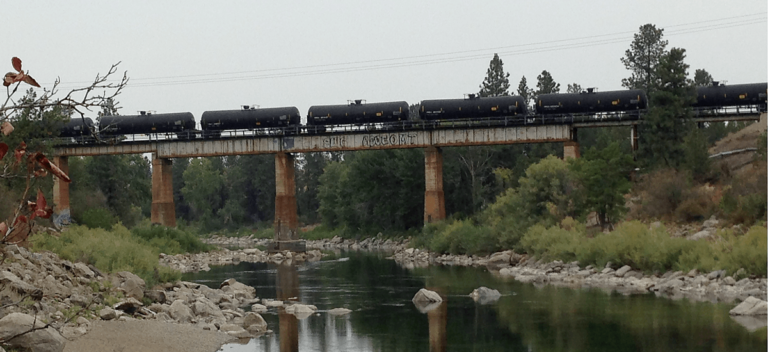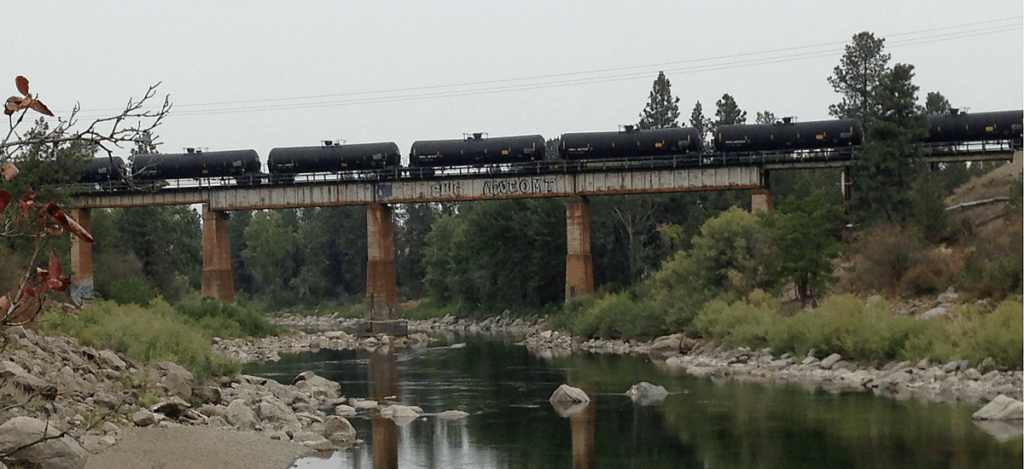
Concerns highlighted in report vindicated
Five months after we released Deadly Crossing, a report highlighting the troubling state of rail bridge safety written with Riverkeeper and ForestEthics, there have been some important developments. While much of the progress made on this issue is small compared to the enormous, immediate threat posed by oil trains traveling over potentially unstable bridges, these developments vindicate many of the concerns we raised in our report.
One of our concerns in Deadly Crossing focused on the lack of transparency surrounding rail bridge safety, as it was largely impossible for stakeholders – including local and state representatives – to get meaningful inspection information about a bridge in their community. Passed in December 2015, the “Fixing America’s Surface Transportation” (FAST) Act includes a provision pushed by Senator Tammy Baldwin that provides a means for local and state officials to request a “public rail bridge inspection report” on bridges in their jurisdiction. The Federal Railroad Administration (FRA), which has previously implored railroads to be more transparent on rail bridge safety, acted quickly to implement this program, launching a website last week with a form for public officials to use.
A very exciting aspect of this provision is that, once an official receives a public bridge inspection report, that record can be released to the general public through the state’s public record request system. While the information that railroads must provide on this report is not as extensive as we would like, this is a fantastic first step towards creating a more transparent and accountable rail bridge inspection system.
The Deadly Crossing Report also highlighted the limited federal oversight of rail bridge safety, noting that there is no federal inventory of rail bridges, that the FRA relies on railroads to inspect their own bridges, and that there is inadequate funding for the FRA to reliably review all the inspection report provided by railroads. Senator Chuck Schumer has long been calling attention to these deficiencies, and now the FRA is taking steps to remedy some of this by requesting additional funds to hire more rail bridge inspectors and create a national inventory. While this is undoubtedly a step in the right direction, news that the FRA is asking to increase the number of inspectors for the approximately 100,000 privately-owned rail bridges in the U.S. from eight individuals to 16 shows the enormous shortcomings in federal regulation of this industry.

These shortcomings were further displayed last week with the release of an audit report of the FRA’s enforcement of hazardous materials regulation by the Department of Transportation’s Inspector General. The report found that the FRA inadequately assessed the risks posed by hazardous cargo, including crude oil, and requires companies to pay only miniscule fines for infractions, even when the violations warrant a criminal investigation. ForestEthics, one of our partners on the Deadly Crossing Report, has an excellent blog post elaborating on what this report means for oil train safety.
We also finally have an answer to what caused the fiery Lynchburg, VA oil train derailment in 2014. Despite industry’s insistence that they are well-equipped to inspect their own infrastructure and make timely repairs, it appears that the cause of the derailment was a defective rail that had been discovered the day before the accident and was scheduled to be repaired the next day. However, CSX did not put the safety of the Lynchburg community first and halt rail traffic for a mere 24 hours until repairs could be completed. They continued to move explosive oil trains over these defective tracks even though they were located in a highly populated area. No governmental agency ordered CSX to stop moving explosive oil trains over the defective tracks until repairs were completed. CSX just continued business as usual and their decision to keep shipping oil over a broken rail line caused the fiery derailment and oil spill that set the James River on fire and required evacuations in Lynchburg. Just two weeks before the derailment, a working group on rail failure made recommendations that would have prevented this derailment. However, since these were recommendations and not requirements, CSX had not implemented them yet at the time of the derailment.
So, in all of this, there is good and bad news. The bad news is that the response of the federal government still is incredibly miniscule compared to the threat posed to communities and waterways by oil trains. The good news – and we already knew this – is that we are not alarmists, crying wolf because rail bridges are not painted to our satisfaction, as industry would have the public believe. Our concerns about rail infrastructure, especially in light of explosive oil train traffic, are valid and continue to be vindicated.